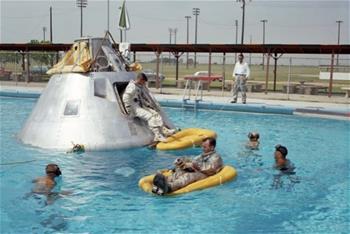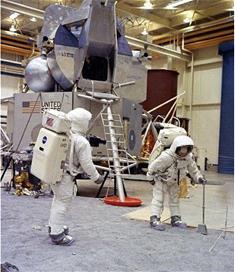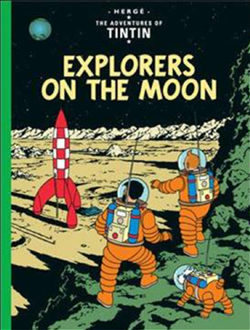Aerospace Micro-Lesson #85
In This Section
The Early Apollo Program
Project Apollo was an American space project which landed people on the Moon and brought them safely back to Earth. Most people know about Apollo 1, in which three astronauts lost their lives in a fire during a countdown rehearsal, and about Apollo 8, which flew to the Moon, orbited around it, and returned to Earth. Just about everybody knows about Apollo 11, which first landed astronauts on the Moon. But what happened in between these missions? This lesson explores the lesser-known but still essential building blocks of the later missions’ success.
Next Generation Science Standards (NGSS):
- Discipline: Engineering Design
- Crosscutting Concept: Systems and System Models
- Science & Engineering Practice: Constructing Explanations and Designing Solutions
GRADES K–2

NASA engineers knew that Apollo astronauts would need special training to succeed in their missions to the moon, but how could they train under conditions similar to those the crew would encounter? One answer was to send them to places with barren areas and volcanic features that were like what they expected to find on the lunar surface.
 The astronauts received geology training as well as practicing maneuvers in their spacesuits and driving a replica of the lunar rover vehicle. Astronauts who would fly the Lunar Module down to the Moon’s surface and back up again also practiced flying something that flew like the Lunar Module; the astronauts nicknamed it the “Flying Bedstead” because that is what it looked like.
The astronauts received geology training as well as practicing maneuvers in their spacesuits and driving a replica of the lunar rover vehicle. Astronauts who would fly the Lunar Module down to the Moon’s surface and back up again also practiced flying something that flew like the Lunar Module; the astronauts nicknamed it the “Flying Bedstead” because that is what it looked like.
 But that was not the only training that was used to prepare the crews. Many of the training experiences used simulators to help the men learn how to move in the reduced gravity of the moon, or to operate equipment such as the lunar lander. Since the crew would splash down in the ocean upon their return, they trained in swimming pools and in the Gulf of Mexico to make sure they could safely exit the spacecraft and board the life rafts that would keep them afloat until the Navy could pick them up. Astronauts also trained at the Panama Jungle Survival School, as well as in deserts in Nevada and Washington in case they did not land in the ocean as planned.
But that was not the only training that was used to prepare the crews. Many of the training experiences used simulators to help the men learn how to move in the reduced gravity of the moon, or to operate equipment such as the lunar lander. Since the crew would splash down in the ocean upon their return, they trained in swimming pools and in the Gulf of Mexico to make sure they could safely exit the spacecraft and board the life rafts that would keep them afloat until the Navy could pick them up. Astronauts also trained at the Panama Jungle Survival School, as well as in deserts in Nevada and Washington in case they did not land in the ocean as planned.Gizmodo, Wired, and Northern Arizona University offer some details about the training exercises and their purpose, along with photos of the astronauts.
GRADES 3–5
Have you ever heard the expression “this isn’t rocket science”? People say that when they mean that something isn’t very difficult. But traveling through space is rocket science, and it is very difficult.
Think for a moment about how you move from one place to another. If you walk, you push against the ground with your feet. You push backwards against the ground and friction—that force which tends to keep things from slipping freely across each other—causes the ground to push forward against you. That forward push from the ground makes you move forward.
Most other methods of transportation work in the same way: they push against something and that something pushes back, causing the vehicle to move. But in space there is nothing to push against. The only way that we know of to move in space is to use rockets. The way a rocket works is that it burns some fuel to get it very hot and then pushes the exhaust gases from the fuel away from itself very hard so that the exhaust gases push back against the rocket very hard. This push of the fuel against the rocket makes the rocket move.
Incidentally, you can show how a rocket works by holding something heavy (and unbreakable!) while sitting in a wheeled office chair or in a swing on the playground. Throw the thing away from you as hard as you can; the force of the throw will push you in the opposite direction. (This also happens when you are standing on the ground, but when you are standing on the ground the friction between your shoes and the ground keeps you from moving.) A rocket works the same way: it pushes the exhaust gases out the nozzle and the exhaust gases push it in the opposite direction.
It takes a very large and powerful rocket to lift something into orbit around the Earth. In addition to carrying the payload—the thing that the scientists want to put into orbit—the rocket also needs to be able to lift itself. Making matters even worse, it even needs to lift the fuel that it is going to burn later on in its flight.
In the 1960s, when scientists were trying to figure out how to get somebody to the Moon and bring him back, they were also still learning how to build rockets. They had figured out how to build rockets large enough to send small spacecraft into orbit around the Earth, and were figuring out how to build them large enough to send spacecraft with people inside them into orbit, but they did not know how to build a rocket large enough to send people to the Moon and bring them home again.
Building a larger rocket is not as easy as simply making everything larger. If you double the linear size of something, its weight increases by a factor of eight while its support area on the ground increases only by a factor of four, effectively doubling the stress on the supports. (This is why deer have graceful hooves while elephant legs resemble tree trunks.) Also, things that one can ignore on smaller scales become important on larger scales. There is an instability called “pogo,” for example, which causes vibrations that can shake a large rocket apart. In a smaller rocket the vibrations are not so severe and do not cause problems.
As NASA prepared to send people to the Moon, they built bigger and more powerful rockets. They would test the rockets and spacecraft, fix problems, and then test them again. When the time came actually to send astronauts to the Moon, the rockets were ready.
GRADES 6–8
History tends to be a little messy. When people are in the middle of doing something for the first time, they focus on getting the job done. Making it look organized is less important and is usually done later.
The early missions in the Apollo space program give us a fine example of this. A list of the early Apollo missions reveals a long list of test flights, some of them with test numbers out of order:
| Designation | Launch Date |
Crew | Destination | Mission |
| SA-1 | 10/27/61 | No | Suborbital | First flight of a Saturn 1, testing aerodynamics and structure |
| SA-2 | 4/25/62 | No | Suborbital | Tested Saturn 1; carried 94 tons of water to create an artificial cloud |
| SA-3 | 11/16/62 | No | Suborbital | First fully-fueled test of Saturn 1 |
| SA-4 | 3/28/63 | No | Suborbital | Tested what the Saturn 1 would do if an engine failed |
| SA-5 | 1/29/64 | No | Earth orbit | First live flight of a Saturn IV upper stage |
| SA-6 | 5/28/64 | No | Earth orbit | First flight of a rocket shaped like a full Saturn V |
| SA-7 | 11/18/64 | No | Earth orbit | Tested the Apollo launch escape system |
| SA-9 / Pegasus 1 |
2/16/65 | No | Earth orbit | Tested Saturn 1 and launched Pegasus 1 micrometeoroid detection satellite |
| SA-8 / Pegasus 2 |
5/25/65 | No | Earth orbit | Tested Saturn 1 and launched Pegasus 2 micrometeoroid detection satellite |
| SA-10 / Pegasus 3 |
7/30/65 | No | Earth orbit | Tested Saturn 1 and launched Pegasus 3 micrometeoroid detection satellite |
| AS-201 | 2/26/66 | No | Suborbital | Tested Saturn 1B and Command Module’s heat shield |
| AS-203 | 7/5/66 | No | Earth orbit | Further testing of Saturn IVB upper stage; sometimes unofficially called Apollo 2 |
| AS-202 | 8/25/66 | No | Suborbital | Tested a variety of systems on the Saturn V; sometimes unofficially called Apollo 3 |
| AS-204 | (1/27/67) | Yes | - | Ended with the deaths of three astronauts in a fire during a launch rehearsal; later renamed Apollo 1 in their honor |
| Apollo 4 | 11/9/67 | No | Earth orbit | First all-up test of the Saturn V rocket |
| Apollo 5 | 1/22/68 | No | Earth orbit | First test of the Lunar Module in orbit |
| Apollo 6 | 4/4/68 | No | Earth orbit | Test of Command module re-entry procedure |
| Apollo 7 | 10/11/68 | Yes | Earth orbit | First crewed flight of an Apollo spacecraft; tested manned operating procedures |
| Apollo 8 | 12/21/68 | Yes | Lunar orbit | First crewed flight beyond Earth orbit |
| Apollo 9 | 3/3/69 | Yes | Earth orbit | Test of Lunar Module operations |
| Apollo 10 | 5/18/69 | Yes | Lunar orbit | “Dress rehearsal” for Moon landing |
There is some further confusion over test designations. SA-6 through SA-10, for example, are elsewhere called AS-101 through AS-105. After the Apollo 1 fire, there was a movement to give the other AS-200 series Apollo mission numbers, but NASA finally decided not to. The Apollo 4 mission was also known as AS-501 and Apollo 6 was also known as AS-502. Apollo 7 went back to the AS-200 series, being designated AS-205.
Examining this list of test missions also shows that the tests became more and more complicated as time went on and the NASA engineers learned from the earlier tests. They tested the Saturn 1 rocket and used what they learned to design and build the more powerful Saturn 1B rocket. They had simpler suborbital (“up-and-down”) tests before they tried putting a Saturn rocket into orbit, and they only tried going to the Moon after they had tested things out thoroughly in Earth orbit.
Notice also that none of the early tests carried people on board. NASA scientists wanted to make sure the rocket would work properly—that it wouldn’t blow up in a massive ball of flame, for example—before letting anybody fly on it. There were many other systems that needed to work before a space capsule could fly with a person inside: something as basic as making sure that the air in the capsule was breathable took a lot of work. This technical paper—and it is technical, but please do not let that frighten you—describes many things that engineers have to account for when designing something to travel to the Moon and land there.
GRADES 9–12
Flying anything in space is governed by two things. The first is the method used to get around in space; since there is nothing in space to push against, we are forced to use rockets that push some mass away from themselves in one direction in order to propel themselves in the opposite direction. The second, since we have to use rockets, is Tsiolkovsky’s Rocket Equation:
.png?sfvrsn=2edc112b_1)
In this equation, “DV” is the change in the speed of the rocket; “Ve” is the speed of the exhaust coming out the rocket nozzle; and “m” and “mfinal” are the masses of the rocket before it has burnt its fuel and after it has burnt its fuel. (The “ln” is the natural logarithm function.) This is an idealized equation; it assumes no friction (such as air resistance from flying through the atmosphere), no losses from pointing the rocket exhaust inaccurately, and no effort to overcome the force of gravity. Deriving this equation is a rather simple exercise in integral calculus; one can also derive a modified version that includes the effort required to overcome gravity:
.png?sfvrsn=f566822d_1)
The Rocket Equation places some serious limits on how well one is able to get around in space. Between the increase in altitude and the achievement of orbital velocity, to get from the surface of the Earth to low Earth orbit requires a DV of about 8 Km/s—not including air resistance. The exhaust speed of the rocket has a fixed upper limit that is specified by the propellants used. The Rocket Equation can be used to translate the change in speed and the exhaust speed into the fraction of the initial rocket mass that must be expended as fuel:
.png?sfvrsn=5bb66f9_1)
We can use this equation to calculate the percent of the rocket which must be fuel in order to be able to go from the surface of the Earth into low Earth orbit, following the tables in the “Tyranny of the Rocket Equation” article (note that the tables in that article are not completely correct):
|
Propellant |
Exhaust Velocity |
Percent Propellant |
|
Solid Rocket |
2.5 Km/s |
96 |
|
Kerosene-Oxygen |
2.9 Km/s |
94 |
|
Hypergolics |
3.0 Km/s |
93 |
|
Methane-Oxygen |
3.4 Km/s |
90 |
|
Hydrogen-Oxygen |
4.5 Km/s |
83 |
Once in space, it is possible to use an ion thruster which, while it generates only a very small thrust, has a much larger (about 30 Km/s) exhaust velocity and so can generate a much larger DV for the same percent propellant.
Since about nine-tenths of the rocket must be fuel—and the non-fuel parts of the rocket must include the engines and fuel tanks along with the payload—engineers have put much effort into finding creative ways to reduce the non-fuel rocket mass. In a multistage rocket, for example, the weights of the enormous engines and fuel tanks in a lower stage fall off and do not need to be transported any more after their fuel is expended.
 The engineers in the Apollo program took this idea to an extreme. The only mass that landed on the Moon was that of the Lunar Module, which was only large enough to bring two astronauts down to the Moon’s surface and bring them back up. And even that was finessed; the Lunar Module was a two-stage vehicle and only the upper stage made the trip from the Moon’s surface back up into lunar orbit. All the mass of the Command and Service Modules, which were to take the astronauts home to Earth, remained in lunar orbit and did not descend to the Moon’s surface. This diagram shows the relative sizes of the different parts of the Saturn V rocket which took the three astronauts to the Moon and back. You may want to contrast this with a depiction of a Moon rocket in popular literature at the time, shown in the picture on the right, in which the entire rocket made both the full trip to the Moon’s surface and the full trip back.
The engineers in the Apollo program took this idea to an extreme. The only mass that landed on the Moon was that of the Lunar Module, which was only large enough to bring two astronauts down to the Moon’s surface and bring them back up. And even that was finessed; the Lunar Module was a two-stage vehicle and only the upper stage made the trip from the Moon’s surface back up into lunar orbit. All the mass of the Command and Service Modules, which were to take the astronauts home to Earth, remained in lunar orbit and did not descend to the Moon’s surface. This diagram shows the relative sizes of the different parts of the Saturn V rocket which took the three astronauts to the Moon and back. You may want to contrast this with a depiction of a Moon rocket in popular literature at the time, shown in the picture on the right, in which the entire rocket made both the full trip to the Moon’s surface and the full trip back.
The advantage of a “mission architecture”—the multiple stages of rocket, the separate Command and Lunar modules, and so on—is that it reduces the initial mass of the rocket to a manageable level. The disadvantage is that it requires a complicated operation—such as docking two spacecraft together—while orbiting the Moon. Learning how to dock spacecraft was a skill that NASA learned in the Gemini program and practiced more in the pre-landing Apollo program.
Sixty Years Ago in the Space Race:
June 8, 1959: The American X-15 hypersonic research rocket plane made its first, unpowered, test flight.
